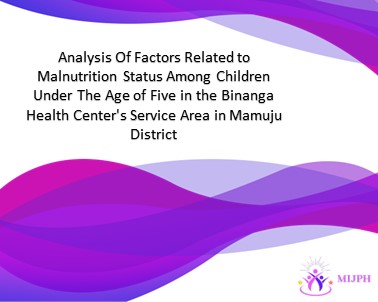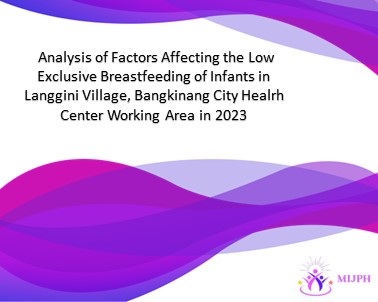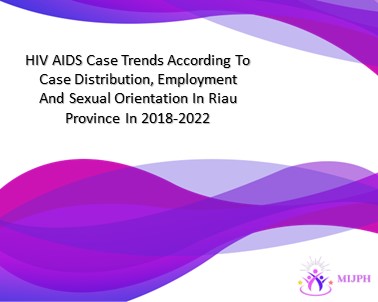Analysis Of Factors Related to Malnutrition Status Among Children Under The Age of Five in the Binanga Health Center's Service Area in Mamuju District

Downloads
Toddlers represent a demographic particularly susceptible to nutritional deficiencies, including malnutrition. Various internal and external factors influence the nutritional well-being of toddlers. This research endeavors to examine the determinants associated with undernutrition among toddlers within the Binanga Health Center's jurisdiction in Mamuju Regency. Employing an analytical observational method with a cross-sectional design, the study involved 30 malnourished toddlers as its sample, selected through purposive sampling, also known as judgmental or selective sampling. Anthropometric measurements were conducted to calculate z-scores, alongside the administration of questionnaires. Findings indicated a significant lack of knowledge regarding nutritional care for toddlers among the majority of subjects, accounting for 54% of cases. Spearman's rank correlation analysis revealed a significant association between maternal nutritional knowledge and toddler malnutrition (p=0.001). Moreover, socioeconomic factors elucidated that 70% of malnourished toddlers originated from impoverished households, with a correlated relationship between family economic status and toddler malnutrition (p=0.003). Furthermore, the educational aspect revealed that 73% of subjects had limited educational attainment, showing a significant correlation between maternal education and toddler malnutrition (p=0.003). Additionally, a notable 63% of malnourished toddlers had a history of low birth weight (LBW), indicating a significant relationship between LBW history and toddler nutritional status (p=0.006) based on Spearman's rank correlation analysis.
Downloads
Adiningsih S. 2010. Waspadai Gii BalitaAnda. PT.Flex Media.Jakarta.
Badan Kebijakan Pembangunan Kesehatan. Buku Saku Hasil Studi Status Gizi Indonesia (SSGI) Tahun 2021. Jakarta: Kementrian Kesehatan Republik.
Black, J dan Hawks, J. 2014. Keperawatan Medikal Bedah: Manajemen Klinis untuk Hasil yang Diharapkan. Dialihbahasakan oleh Nampira R. Jakarta: Salemba Emban Patria.
Mustar, 2022. Hubungan Pengetahuan Ibu Tentang Gizi Dengan Status Gizi Balita Di Wilayah Kerja Puskesmas Watampone, Jurnal Suara Kesehatan, Vol 8, No. 1, Februari 2022.
Riset Kesehatan Dasar (Riskesdas) (2018). Badan Penelitian dan Pengembangan Kesehatan Kementerian RI tahun 2018.
Indonsia; 2021. Available from: https://www.badankebijakan.kemkes.go.id/.
buku-saku-hasil-studi-status-gizi-indonesia-ssgi-tahun-2021/
Uki Nengsih, Noviyanti dan Dedi S. Djamhuri, 2016. Hubungan Riwayat Kelahiran Berat Bayi Lahir Rendah Dengan Pertumbuhan Anak Usia Balita. Midwife Journal, volume 2, No. 2, Juli 2016.
UNICEF, WHO, World Bank Group. Level and Trends in Child Malnutrition. Who. 2021;24(2):51-78. https://www.who.int/publications/i/item/9789240025257











